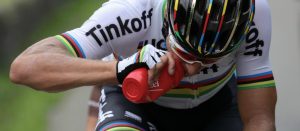Sweat rates for real people. by K.N.*
 The human body functions in optimum operation when in the eu-hydrated state. That been said, the loss of fluids will jeopardize sports performance, and if this escalates with further losses, health issues will arise. During long endurance sports, sweat loses occur via various avenues, with a purpose to remove the excess heat build-up, and cool off the body aiding thermoregulation. As an initial understanding, these sweat rates under exercise conditions are manifested in a range of 0.8 to over 2 l/hour. However it has been recorded (by Armstrong et. al., 1986) that the marathon runner Alberto Salazar in the 1984 Olympic marathon had an amazing sweat rate of 3.7 l/hour.
The human body functions in optimum operation when in the eu-hydrated state. That been said, the loss of fluids will jeopardize sports performance, and if this escalates with further losses, health issues will arise. During long endurance sports, sweat loses occur via various avenues, with a purpose to remove the excess heat build-up, and cool off the body aiding thermoregulation. As an initial understanding, these sweat rates under exercise conditions are manifested in a range of 0.8 to over 2 l/hour. However it has been recorded (by Armstrong et. al., 1986) that the marathon runner Alberto Salazar in the 1984 Olympic marathon had an amazing sweat rate of 3.7 l/hour.
We need to have in mind that there are outliers, athletes outside these ranges, and extreme climatological conditions can exacerbate this. Worth noting that during hot and dry conditions the sweat rates can be greater, Vs hot and wet conditions.
Since 70% of the adult human body is comprised by water, during these “stressful” situations namely sports, meticulous care about replenishing fluids should be a priority. Losing fluids that reflect close to 1% of your body weight can cause a drop in performance, and an alarming 10% loss can possibly lead to fatality. Fitter or well acclimatized to heat athletes, tend to sweat more facilitating this cooling process, whereas less fit / less acclimatized individuals demonstrate lower sweat rates thus resulting in a greater physiological strain.
How do you ensure that you address fluid loses in an Ironman or half Ironman event solving this tough puzzle successfully? Since certain people can reach up to a staggering fluid loss of 2 or 2.5 l/hour including mostly Sodium chloride the most abundant of electrolytes, but also potassium, magnesium, and calcium are present in lower amounts, the hydration plan needs a good amount of thinking. We will not dive deep in this article about what kinds of substances were lost and what needs to be replenished, but purely fluid quantity and striking a basic balance.
Since on the bike your supply of fluids can be adequate assuming the carrying capacity and feed zones available in events do provide the necessary beverages helping you replenish. During the development of the bike leg though, concentration can drift into confusion making the athlete forget how many 0,75 L bottles she consumed. Let’s look at this example for our female athlete weighing 60 kg with a sweat rate of 1,5 l/hour, during a 90km bike with a (for the sake of our discussion) 3 hour duration, will pretty much have this calculation below to discuss.
Sweat loss 1,5 L x 3 hours =4,5 liters lost
Intake 750 ml x 3 bottles = 2,25L Deficit 2,25 L
equivalent to 2,25 kg
equivalent to 3,8 % of her body weight.
The approximate equation above shows that the athlete is in a fluid deficit, a significant body weight loss (by fluids), and that means that this loss, right before she is ready to start a race- pace half marathon will put her in a dis-advantageous position. If she expects to have her physiology tuned in and perform her run, she needs to address this immediately, or better yet should have done something half way on the bike. Apparently her refueling strategy in the provided stations was not enough to prevent dehydration, and the fluid loss will have consequences. To name a few, higher heart rates and a feeling of mild disorientation without the ability to perform at her expected race pace, due to a greater perceived exertion.
A take home message for all endurance athletes out there training in hot environments, can be the weighing pre/post workout and work out any intake of fluids on the bike/run to assess the situation. By this action a methodology can be developed, and test after test to figure out what works best, can be the path to knowing your physiology even better during exercise.
Worth noting that excessive drinking can also lead to adverse effects as well, such as bloating or hyponatremia, and gastrointestinal distress, which definitely is not the perfect situation for a PB.
*Kypros Nicolaou is an Exercise Physiologist, graduate of the University of Alabama, an ACSM certified Health & Fitness Instructor, holds an ITU Level II Certification as a Triathlon Coach, and is a multiple Ironman & Half Ironman Triathlon finisher. He is coaching Triathletes online, teaches Functional Training at f/3dfts, and performs Exercise Physiology assessments at the Cyprus Sports & Research Center. e –info@ryltoday.com


No Comments